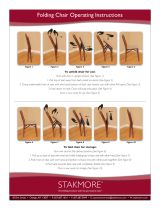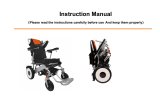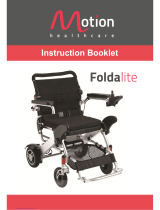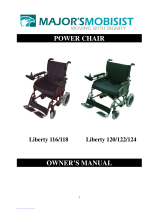
Folding Power Chair
PHFW-1118 PHFW-1120
PHFW-1018 PHFW-1020
OWNER’S MANUAL

6/25/2004
2
Table of Contents
INTRODUCTION ................................................................................ 3
EMI WARNING................................................................................... 4
SAFETY INSTRUCTIONS ................................................................. 6
IMPORTANT NOTES......................................................................... 7
USING THE SHOPRIDER FOLDING POWER CHAIR ..................... 9
GETTING TO KNOW THE JOYSTICK CONTROLLER (VSI 50) .................................................................... 9
DRIVE/FREEWHEEL MECHANISM ............................................................................................................ 10
TRANSFERRING ....................................................................................................................................... 11
FOLDING THE WHEELCHAIR .................................................................................................................... 12
ARMRESTS ............................................................................................................................................... 13
SWING-AWAY, DETACHABLE LEG RESTS ............................................................................................... 13
RAMPS, SLOPES AND CAMBERS ............................................................................................................. 14
LOOKING AFTER YOUR POWER CHAIR ..................................... 15
TIRES ....................................................................................................................................................... 15
UPHOLSTERY ........................................................................................................................................... 15
LUBRICATION AND GENERAL MAINTENANCE .......................................................................................... 15
BATTERIES & BATTERY CHARGING ........................................... 16
BATTERY CHARGING PROCEDURE ............................................ 16
TROUBLESHOOTING ..................................................................... 17
SPECIFICATION.............................................................................. 19
QUARTERLY INSPECTION ............................................................ 20
FPC-11 BATTERY INSTALLATION (PHFW-1118/PHFW-1120).... 21
NOTES ............................................................................................. 22
DISCLAIMER ................................................................................... 24

6/25/2004
3
INTRODUCTION
Congratulations on insisting the best. The Shoprider folding power
chair is the ultimate combination of style and comfort. The
compact folding feature supports easy transportation of your
Shoprider power chair for today’s active lifestyle. We hope that it
will provide many years of mobility for you.
This manual contains important information regarding the safe use
of the Shoprider folding power chair. Please read it carefully
before using and make sure you understand all the instructions.

6/25/2004
4
EMI WARNING
Electromagnetic Interference (EMI) from Radio Wave Sources
Powered electric chairs may be susceptible to electromagnetic
interference, which is a kind of interfering electromagnetic energy
(EMI) emitted from sources such as radio stations, TV stations,
amateur radio (HAM) transmitters, two-way radios and cellular
phones. The interference (from radio wave sources) can cause the
power chairs to release its brakes, move by itself or move in
unintended directions. It can also permanently damage the powered
chair’s control system.
The sources of radiated EMI can be broadly classified into three
types:
1. Hand-held portable transceivers (transmitters-receivers) with
the antenna mounted directly on the transmitting unit.
Examples include: citizens band (CB) radios, “walkie talkies”,
security, fire and police transceivers, cellular telephones and
other personal communication devices
NOTE: Some cellular telephones and similar devices transmit
signals while they are ON, even when not being used.
2. Medium-Range mobile transceivers, such as those used in
police cars, fire trucks, ambulances and taxis. These usually
have the antenna mounted on the outside of the vehicle.
3. Long-Range transmitters and transceivers, such as commercial
broadcast transmitters (radio and TV broadcast antenna
towers) and amateur (HAM) radios.
NOTE: Other types of hand-held devices, such as cordless
phones, laptop computers, AM/FM radios, TV sets, CD
players, cassette players and small appliances such as
electric shavers and hair dryers, so far, as we know, are not
likely to cause problems to your power chair.

6/25/2004
5
Powered Chair Electromagnetic Interference (EMI)
Because EMI energy rapidly becomes more intense as one moves
closer to the transmitting antenna (source), the EMI fields from hand-
held radio sources (transceivers) are of special concern. It is
possible to unintentionally bring high levels of EMI energy very close
to the power chair’s control system while using these devices. This
can affect powered chair movement and braking. Therefore, the
warnings listed below are recommended to prevent possible
interference with the control system of the powered chair.
WARNINGS
The following warnings listed below should reduce the chance of
unintended brake release or power chair movement, which could
result in serious injury.
1. Do not operate hand-held transceivers (transmitter-receivers),
such as citizens band (CB) radios, or turn ON personal
communication devices, such as cellular phones, while the
power chair is turned ON.
2. Be aware of nearby transmitters, such as radio or TV stations,
and try to avoid coming close to them.
3. If unintended movement or brake release occurs, turn the
power chair OFF as soon as it is safe.
4. Be aware that adding accessories or components, or modifying
the power chair may make it more susceptible to EMI.
NOTE: There is no easy way to evaluate the overall immunity
of the powered chair.
Report all incidents of unintended movement or brake to the power
chair provider, and note whether there are sources of EMI nearby.

6/25/2004
6
Safety Instructions
Please do use the folding power chair to enhance your active
lifestyle. With increased mobility, please observe a few rules to
ensure safe operation of your folding power chair. So please…
1. Do not drive the folding power chair without reading this
manual.
2.
Do not exceed the safe climbing maximum angle (Table 2).
3.
Do not use the joystick in an erratic manner when going up or
down an incline.
4.
Do not carry passengers or exceed the maximum weight limit
(Table 2).
5.
Do not turn off the joystick controller by switching the On/Off
Button when moving at speed. This will bring the
electromagnetic brakes on immediately and could cause
damage to the joystick controller.
6.
Do not drive over deep and soft terrain (soft dirt, loose gravel,
deep grass).
7.
Do not attempt to mount a curb height above 2 inches.
8.
Do not mount or dismount the folding power chair unless the
electromagnetic brakes are engaged and the joystick
controller is off.
9.
Do not operate the folding power chair if the unit is in
freewheel mode.
10.
Do not use on the road, except when crossing between
sidewalks.
11.
Do not sit on the folding power chair when in a vehicle, but
transfer to a vehicle seat.
12.
Do not exceed any grade over 8 degrees (14%).
13.
Always stop fully before changing forward or reverse
direction.
14.
Always engage a slow speed when going down gradients
(move the joystick slowly towards center position to reduce
the speed).
15.
Always approach and climb over curbs at slow speed.
16.
Always approach curbs and gradients at 90 degrees.
17.
Always use the safety belt.

6/25/2004
7
18. Always keep the feet on the leg rest while driving.
19.
Always make sure the batteries are fully charged before
setting out on a journey.
20.
Always charge the folding power chair in a well ventilated
area to prevent any possible risk.
21.
Always check that the drive wheels are engaged. Someone
may have left the folding power chair in freewheel mode.
22.
Always reduce your speed when turning sharply.
23.
Avoid turning sharply on a slope or gradient.
24.
To brake in an emergency simply release the joystick.
25.
Always try to find a “dropped curb” or “curb cutout” whenever
possible.
26.
Always keep your folding power chair properly maintained.
27.
Never try to use your folding power chair beyond it’s
limitations as described in this manual.
Important Notes
The FPC-11 power chair is designed to assist in your individual
mobility needs. Any usage outside of the guidelines in this manual
may result in damage to the chair or injury to the user or third party.
1. Do not lift the wheelchair by the armrests
2. Do not lift the wheelchair by the footrest brackets
3. You can program the controller in conjunction with your supplier
to fine-tune the wheelchair performance characteristics.

6/25/2004
8
Feature Guide
Figure 1
1. Armrest (height adjustable and flips up for transferring)
2. Joystick Controller
3. Charging Port
4. Seat
5. Standard Swing Away Leg rest (Elevating Leg Rest
Optional)
6. Front Castor (8” flat free tire)
7. Frame Serial Number (13 alphanumeric characters)
8. Rear Drive Wheel (12” flat free tire)
9. Anti-tip Wheel
10. Push Handle (foldable for compact storage and
transportation)
1
2
3
4
5
6
8
9
10
7

6/25/2004
9
Using the Shoprider Folding Power Chair
Figure 2
Getting To Know The Joystick Controller (VSI 50)
1. On-Off Button: This button turns the joystick controller
(hereinafter referred to as VSI) on and off. Do not use this
button to stop the folding power chair, except in an
emergency.
2. Battery Gauge: This is a 10-segment display, which
indicates if the VSI is switched on and gives the state of
charge of the battery. Additionally, any faults in the folding
power chair electrical system are also indicated by this
display. Refer to Table 1 for more details.
3. Maximum Speed Indicator: This is a 5-segment display,
which indicates the maximum speed setting selected.
1
2
3
4
5 6
7
8

6/25/2004
10
4. Horn Button: This button operates the power chair’s horn.
5. Speed Decrease Button: This button decreases the
maximum speed.
6. Speed Increase Button: This Button Increases the
maximum speed.
7. Joystick: This controls the speed and direction of the
folding power chair. Push the joystick in the direction you
want to go. The further you push it, the faster the speed will
be. Releasing the joystick will automatically engage the
brakes and stop the folding power chair.
8. Charging Port for Off-Board Charger: Only plug into this
port with the qualified charger certified by the original
manufacturer of the folding power chair. This port should not
be used as a power supply for any other electrical devices.
The behavior against the two statements above will void the
warranty of the folding power chair.
The controller can be fitted to suit either right or left-handed users.
Drive/Freewheel Mechanism
The drive/freewheel mechanism is situated to the rear of the chair
at the motors. These levers will allow you to disengage the drive
mechanism and have the power chair in freewheel mode. Always
leave the chair in drive mode, the free wheel facility is there only to
allow the chair to be pushed manually when the need arises (i.e.,
to store or push out of a tight space).
Figure 3 Figure 4
Drive
Freewheel

6/25/2004
11
Transferring
You can transfer either forward, left or right from the chair. The
armrests are hinged in the back and can swing up out of the way
for transfers. Press “buttons” at front of armrest bar (on either
side) to release armrest (see figures 5 and 6).
Assisted transfer; for a wheelchair user who cannot bear any
weight on their legs, and cannot transfer independently, the use of
an appropriate hoist is recommended.
Any carrier who assists in physically transferring the wheelchair
user must be properly trained in modern moving and handling
techniques.
Figure 5
Figure 6
Press button
to release

6/25/2004
12
Folding the Wheelchair
To fold the wheelchair, it is necessary to remove certain
components. Follow these simple guidelines:
1. Park the chair on a level surface.
2. Ensure the wheels are in drive mode.
3. Fold up footplates and/or remove the entire leg rest assemblies
(see Figures 8, 10 and 11).
4. Disconnect the black and red connectors situated under the
seat (Figure 7).
5. Carefully pull out the first rear battery out of the basket by using
the lifting strap (battery is heavy). Then pull out the battery
basket by lifting up.
6. Slide second battery forward and follow the same steps as 5. to
pull out the second battery and basket
7. Remove seat cushion, carefully place hands under the seat
bottom and give a sharp pull upward. This will pull the entire
frame together (Figure 8).
Connectors
Lifting Straps
Pull Seat Bottom
Upward
Battery
Basket
Figure 7 Figure 8

6/25/2004
13
Armrests
The armrests are height adjustable and can flip up out of the way for
side transfers. To adjust the height, simply pull the knob outward and
lift armrest up or down to your comfort. The adjustments are in 1 ½”
increments.
Figure 9
Swing-Away, Detachable Leg Rests
The swing away leg rests are detachable. To remove the leg rest,
remove the Velcro strap, push silver lever inward, swing leg rest
outward and lift up.
Figure 10 Figure 11
Pull knob outward
Lift or lower by handle
Pull tab to fold
backrest for
transport

6/25/2004
14
Negotiating Obstacles
Ramps, Slopes and Cambers
The FPC-11 indoor/outdoor power chair has the ability to negotiate
ramps, slopes and cambers of a low to medium gradient. It is of the
utmost importance that the following points are observed:
1. Never attempt to go up or down an incline which has a rough,
wet or slippery surface (loose gravel, tree roots, wet grass,
polished floor, etc.)
2. Always approach an incline head on, not at an angle
3. Always travel at a speed that you are comfortable with and that
you feel in complete control
4. Avoid sudden or erratic action with the joystick
5. When riding along in a straight line you may experience
“veering to one side”. This is due to the natural camber in the
construction of the pavement. To correct this you simply have
to steer slightly against it, as you continue to move forward.

6/25/2004
15
Looking After Your Power Chair
Tires
Since your tires are flat frees, there is no need to ever worry about
tire pressure.
Upholstery
All upholstery can be washed with warm water and mild soap. Some
car upholstery cleaners produce excellent results as well.
Occasionally check the seat and back for sagging, cuts and tears.
Replace if necessary. To avoid mildew and rapid deterioration of
upholstery parts, do not store your chair in damp conditions.
Lubrication and General Maintenance
All moving mechanisms will benefit from simple lubrication and
inspection. Lubricate using petroleum jelly or light oil. Do not use too
much oil, drips may stain or damage carpets, furnishing, etc. Always
carry out a general inspection of all nuts and bolts for location and
tightness.

6/25/2004
16
Batteries & Battery Charging
The Shoprider folding power chair is designed to operate on two U1
(2 x 33/34/36 Ah) gel, or sealed lead acid, maintenance free
batteries. For easy handling, Velcro or plastic carrying straps are
provided to assist in fitting or removal. The duration of the batteries
can be affected by temperature, terrain and weight of the user. The
battery gauge is a guide on the remaining charge in the batteries.
The active user will need to charge the batteries after using
approximately more than 30% of battery capacity. As an inactive
user, only using from once a week to every other day, the recharge
point would be at 50% of discharge.
In only using for short distance each day, it is advisable to charge at
the end of each week.
Batteries should be kept fully charged at all times. They must not be
left in a discharged state if not using the unit for some time. The
batteries should be checked once a month and recharged as needed.
Battery Charging Procedure
To recharge the folding power chair, connect the charger to the
Charging Port at the front of the VSI referred to as (8) in Figure 2.
Switch on the charger.
Do not leave the charger plugged into the Charging Port if the
charger is not charging. This charger is for indoor use only. Do not
expose it to rain or water spray. Do not cover the battery charging
vent.
One example of indicator light on the charger gives advice as follows:
Red - Power on
Amber - Battery charging
Green - Charging complete
Please refer to the LED indicator description based on charging
status of the charger.

6/25/2004
17
Troubleshooting
The Self-Help Guide (Table 1) is intended to assist in the location of a
fault that may occur in a certain part of the power chair.
If after checking out the fault from the table below and the fault is still
showing, do not use the power chair. Turn off the power and consult
your provider immediately.
Table 1
LOCK MODE: The VSI controller can be locked to prevent
unauthorized use. The locking method is achieved through a
sequence of key presses and joystick movements, as detailed below.
To lock Powerchair controller:
While the controller is switched on, depress and hold the on/off
button.
After 1 second the controller will bleep. Now release the on/off
button.
Push the joystick forward until the controller bleeps.
Push the joystick in reverse until the controller bleeps.
Release the joystick, there will be a long bleep.
The Powerchair controller is now locked.
To unlock the Powerchair controller:
Use the on/off button to switch the controller on. The maximum
speed/profile indicator will be rippling up and down.
BATTERY
GAUGE
POSSIBLE FAULT
10 Bars flash Battery voltage is too high, Check the battery connections.
9 Bars flash Solenoid brake fault
8 Bars flash Possible joystick controller fault
7 Bars flash Possible joystick fault
6 Bars flash Battery charger connected
5 Bars flash Right-hand motor wiring fault
4 Bars flash Right-hand motor disconnected
3 Bars flash Left-hand motor wiring fault
2 Bars flash Left-hand motor disconnected
1 Bar flashes Low battery voltage

6/25/2004
18
Push the joystick forward until the controller bleeps.
Push the joystick in reverse until the controller bleeps.
Release the joystick, there will be a long bleep.
The Powerchair is now unlocked.
SLEEP MODE: If the controller is left on and not used for more than
ten minutes, the controller will automatically “go to sleep”. This is
recognized by a slow intermittent flash of the battery indicator lights.
Simply turn the controller off and back on to reset.

6/25/2004
19
Specification
Table 2
Overall Dimensions: L
1
x W x H 43.3 x 24.4 x 37 In
Number, Size of Front Tires 2, 8 inches
Number, Size of Rear Tires 2, 12 inches
Total Weight (w/o batteries) 95 Lb
Battery Capacity 12V 28-36Ah x 2 _V_Ah x _pcs
Charger Off Board, 4 amp
Maximum Speed 3.75 Mph
Safe Climbing angle (based on
user weight of 200 lbs/90 kgs)
8 (14) Degrees (%)
Range
2
19 Mile
Turning Radius 24”
As a part of our ongoing product improvement initiative, Shoprider
reserves the right to change specifications and design without prior
notice. All specifications and dimensions are approximate.
1
Including the Anti-Tip wheel.
2
The actual driving range varies with the factors shown below:
1. the weight of the occupant
2. ground surface condition
3. battery condition
4. type of charger
5. ambient temperature
6. driving style
7. Etc.

6/25/2004
20
QUARTERLY INSPECTION
For your own safety, quarterly inspection and service on the product has
to be performed and signed by an authorized dealer. Maintenance
records (below) should be kept at all times. The manufacturer /
distributor / vendor will be indemnified from any product liability claim if
the above maintenance / service requirement is not met.
NOTE! Regular (Monthly) inspection is strongly recommended by
the manufacturer to ensure ultimate performance of the vehicle.
Service Record: Date of Purchase: / /
Purchaser:__________________ Model #: ____________ Serial #: _______________
Dealer Unit Was Purchased From: _______________________________
M / D / Y M / D / Y M / D / Y M / D / Y M / D / Y M / D / Y
M / D / Y M / D / Y M / D / Y M / D / Y M / D / Y M / D / Y
M / D / Y M / D / Y M / D / Y M / D / Y M / D / Y M / D / Y
M / D / Y M / D / Y M / D / Y M / D / Y M / D / Y M / D / Y
M / D / Y M / D / Y M / D / Y M / D / Y M / D / Y M / D / Y
M / D / Y M / D / Y M / D / Y M / D / Y M / D / Y M / D / Y
Page is loading ...
Page is loading ...
Page is loading ...
Page is loading ...
-
 1
1
-
 2
2
-
 3
3
-
 4
4
-
 5
5
-
 6
6
-
 7
7
-
 8
8
-
 9
9
-
 10
10
-
 11
11
-
 12
12
-
 13
13
-
 14
14
-
 15
15
-
 16
16
-
 17
17
-
 18
18
-
 19
19
-
 20
20
-
 21
21
-
 22
22
-
 23
23
-
 24
24
Shoprider PHFW-1020 User manual
- Category
- Scooters
- Type
- User manual
Ask a question and I''ll find the answer in the document
Finding information in a document is now easier with AI
Related papers
-
Shoprider Como Owner's manual
-
Shoprider FPC none User manual
-
Shoprider P424L User manual
-
Shoprider P424L User manual
-
Shoprider UL8W36 User manual
-
Shoprider UL7WR-12 User manual
-
Shoprider SR_XLR14 R6V3 User manual
-
Shoprider 888WNLL User manual
-
Shoprider WS 888WS User manual
-
Shoprider ULWR11 User manual
Other documents
-
 Stakmore 4540.6H792 User manual
Stakmore 4540.6H792 User manual
-
Kmart 43047918 User manual
-
 Hover Move Lite User manual
Hover Move Lite User manual
-
 Motion Healthcare Foldalite Operating instructions
Motion Healthcare Foldalite Operating instructions
-
EZee Life CH4061 & CH4062 G2 EZee Fold Power Wheelchairs User manual
-
EZee Life CH4055 G1 EZee Fold Power Wheelchairs User manual
-
EZee Life CH4065 EZee Fold Power Wheelchair User manual
-
EZee Life CH4065 User manual
-
Portal HM-047 Operating instructions
-
 Major's Mobisist Liberty 122 Owner's manual
Major's Mobisist Liberty 122 Owner's manual



























